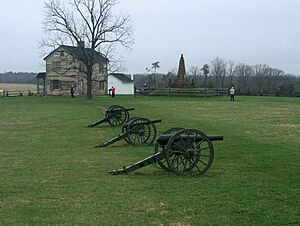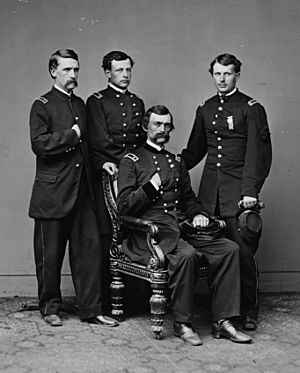Charles Griffin facts for kids
Quick facts for kids
Charles Griffin
|
|
|---|---|
 |
|
| Born | December 18, 1825 Granville, Ohio |
| Died | September 15, 1867 (aged 41) Galveston, Texas |
| Place of burial |
Oak Hill Cemetery, Washington, D.C.
|
| Allegiance | United States of America Union |
| Service/ |
United States Army Union Army |
| Years of service | 1847–1867 |
| Rank | |
| Commands held | V Corps |
| Battles/wars | Mexican–American War |
Charles Griffin (born December 18, 1825 – died September 15, 1867) was an important officer in the United States Army. He became a Union general during the American Civil War. He led a large group of soldiers called a corps in the Army of the Potomac. He fought in many big battles in the eastern part of the country.
After the war, he helped rebuild Texas during a time called Reconstruction. He strongly supported the rights of formerly enslaved people. He also helped replace state officials in Texas who had supported the Confederacy with those loyal to the Union.
Early Life and Military Training
Charles Griffin was born in Granville, Ohio. He went to Kenyon College and then to the U.S. Military Academy in West Point, New York. He graduated in 1847.
After West Point, he became a second lieutenant. He served in the Mexican–American War. Later, he was promoted to first lieutenant in 1849. He worked in the New Mexico Territory until 1854. After that, he taught artillery tactics at West Point.
Serving in the Civil War
When the Civil War began, Captain Griffin led a special artillery unit. It was called the "West Point Battery." This unit fought in the First Battle of Bull Run in July 1861. In December 1861, he married Sallie Carroll.
Griffin continued to lead his battery in the 1862 Peninsula Campaign. He was promoted to brigadier general in June 1862. He then led a group of infantry soldiers. He fought well at Gaines's Mill and Malvern Hill. His soldiers were also involved in the Battle of Antietam.
Griffin was known for being a strong leader. He was given command of a larger group called a division in the V Corps. He served in the Battle of Fredericksburg and the Chancellorsville Campaign.
He became ill and missed the start of the Gettysburg Campaign. But he returned as the battle ended. His soldiers were very happy to see him back. He led his division through many major battles in 1864. These included the Overland Campaign and the Siege of Petersburg.
In December 1864, President Abraham Lincoln nominated him for a higher rank. He became a major general of volunteers. Griffin took command of the V Corps during its final campaign. He was present when General Robert E. Lee surrendered at Appomattox Court House.
After the War
After the war, Griffin became a colonel in the regular army. He was sent to Galveston, Texas. He worked as an assistant commissioner for the Freedmen's Bureau in Texas. This group helped formerly enslaved people.
He became involved in Texas politics. He helped register both Black and white voters. He also made sure that people who had supported the Confederacy could not serve on juries. Griffin convinced General Philip H. Sheridan to remove the governor of Texas. They replaced him with a governor loyal to the Union. They also removed other state officials who had supported the Confederacy.
Griffin was then assigned to lead the Fifth Military District. But before he could move to his new post, he died. He passed away during a yellow fever outbreak in Texas. He is buried in Oak Hill Cemetery in Washington, D.C..
Later, Fort Griffin in Texas was named in his honor.
Images for kids





